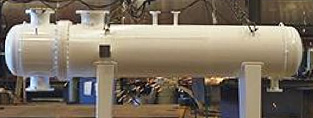
- (03) 5909 8218
- enquiry@fusionweld.com.au
Effective Parameters on Optimum Pressure Vessel Design
May 18, 2016

Pressure vessels are in use in many industrial applications. They vary in shape from a basic fuel storage tank to an intricately designed nuclear reactor vessel. The engineering theories in place in all of these disciplines have a tough task. They provide physical solutions based on client parameters, defined applications that mandate the inauguration of clearly defined criteria as set by fluid constraints. Once defined in computer space, optimum pressure vessel design practices begin, leading to configurations expressed in geometrically elegant forms.
Material Parameters
In beginning with the substance of the stored medium, let's begin with a unique scenario, the nuclear reactor. The particles radiated by this energetic substance can cause embrittlement and substance degradation, which indicates a need to select special alloys. Welding and structural needs in this unique scenario are necessarily exacting, to say the least. Of course, the above example is mostly there as a means of underlining the work practices used to create an optimum pressure vessel design model. Most products are used to store fuel or work within chemical processing plants. Still, the properties of the stored fluid represent a primary parameter here, with some substances, ammonia, for example, requiring refrigeration treatment or a high-temperature operational setting. Weld seams and refined rolled metals should be selected in accordance with the characteristics of the alloy when temperature transients are added to the engineering mathematics. In our ammonia example, the geometrical outline typically defaults to the perfect geometrical outline, the sphere.
Fluidic Constraints
The volumes held and the pressures stored in each vessel act as an elongating lever, pushing the ideal geometry of a stress-relieving sphere outward. The hemispheroid end caps are welded to a rolled cylinder and assessed for complex functions, including those of a heat exchanger, storage containment medium, or that of a processing capsule. The former and latter variants require the most design work, as the vessel will undergo dynamic stress. But remember, a regulated storage tank is still open to such changes as the vessel walls expand and contract due to the pressure equaling phenomenon's that take place when pressure differentials attempt to reach a state of equilibrium.
On top of fluid stored and any effective state changes, we add mechanical outfitting, the internalized tubes and fixtures that fill heat exchangers. The number of parameters can be condensed by applying established geometrical profiles, but each project must always be treated as a unique vessel, a sealed chamber that must safely hold its dangerous content.
Contact Details
Fusion - Weld Engineering Pty Ltd
ABN 98 068 987619
1865 Frankston Flinders Road,
Hastings, VIC 3915
Ph: (03) 5909 8218
Optimized by NetwizardSEO.com.au
Recent Posts
- Compressed Hydrogen Storage Vessels: Material Selection, Design & Australian Standards
- Welding QA/QC in Oil & Gas Pressure Vessel Fabrication – Ensuring Code Compliance
- AS1210 vs ASME VIII Pressure Vessel Code: Key Differences for Australian Projects
- Mitigating Hydrogen-Induced Cracking in Pressure Vessels: Engineering and Material Strategies
- Storage Tank Solutions Australia: Field-Erected, Prefabricated & Self-Bunded Explained
- Reducing Environmental Risks: Self-Bunded Tanks in Australian Oil & Gas Operations
- Precision in Production: How Pressure Vessels Are Manufactured for Industrial Safety
- Shell & Tube Heat Exchangers: Improve Thermal Control & Energy Recovery in Petrochemical & Pharmaceutical Plants
- In-Service Inspection for Compressed Air Receivers for Power Plant Shutdown Prevention
- Power Plant Pipe Spooling Fabrication – Get Rapid, Code-Compliant Spools Ready for Installation
- Field Erected Tanks: Safe, Reliable On-Site Fuel Storage Solutions in Australia
- Custom Pressure Vessel Fabrication for Flammable Gases
Posts 2025
- Compressed Hydrogen Storage Vessels: Material Selection, Design & Australian Standards
- Welding QA/QC in Oil & Gas Pressure Vessel Fabrication – Ensuring Code Compliance
- View all articles…
Posts 2024
- Large Process Vessels: Optimising the Design for Maximum Efficiency [2025]
- Pressure Equipment Management System Installation: Detect Equipment Faults Early
- View all articles…
Posts 2023
- Pressure Piping System Inspection: A Gift of Safety for the Holidays
- Deaerator Inspections by Fusion-Weld Engineering and How They Reduce System Downtime
- View all articles…
Posts 2022
- How Fusion Weld Keeps Up With AS-NZS ISO 9001:2008 Standard
- Boiler Equipment Safety Inspection During the Summer Season
- View all articles…
Posts 2021
- Avoid These Factors and Practices that Contribute to Sealing Damage in Pressure Vessels
- Do's And Don'ts Of Industrial Boiler Inspection And Maintenance From Fusion-Weld
- View all articles…
Posts 2020
- What are the Risks and Hazards Involved in Pressure Vessel Equipment?
- How to Know if Your Pressure Equipment Needs Repair or Replacement?
- View all articles…
Posts 2019
- Factors that Contribute to Pressure Vessel Failure
- Pressure Vessel Regulations in Australia: What are the Mandatory Requirements?
- View all articles…
Posts 2018
- Pros and Cons of Spherical vs. Cylindrical Pressure Vessels
- What are the Different Hazard Levels in Pressure Vessels?
- View all articles…
Posts 2017
- Transportable Pressure Vessels: The Importance of Inspection and Safety Checks
- Fracture Mechanics and Stress Analysis of Cracks in Pressure Vessels
- View all articles…
Posts 2016
Posts 2015
- What Are Deaerators & Feedwater Vessels?
- Precautions and Safety for Compressed Air Receiver Vessels
- View all articles…
Posts 2014
- Demonstrating In-process Inspection Procedures
- Static Grounding Practices and Standards
- View all articles…